Posts Tagged ‘Seshadri Ramaswamy’
-
A CURIOUS DISCOVERY
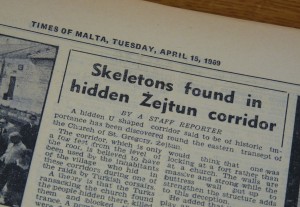 Skeletons found in hidden Żejtun corridor reported the Times of Malta on Tuesday, 15 April 1969. A photo of sacristan Ġann Marì Debono holding a skull in his hand accompanied the news of this remarkable discovery which up to this day is still shrouded in mystery and imbued with controversy.
Skeletons found in hidden Żejtun corridor reported the Times of Malta on Tuesday, 15 April 1969. A photo of sacristan Ġann Marì Debono holding a skull in his hand accompanied the news of this remarkable discovery which up to this day is still shrouded in mystery and imbued with controversy.I have been investigating and researching this find, often by interviewing persons who declared to have been involved in this discovery. My findings were discussed during a national symposium which was organized by Wirt iż-Żejtun in 2014 and later published in the book The Turkish Raid of 1614 which was issued by the same NGO.
 I never got the opportunity to talk to Ġann Marì Debono since he passed away in 2001, at the age of 78. Therefore, I accepted gladly the invitation of his eldest son Charles Debono who offered to share with me his father’s story.
I never got the opportunity to talk to Ġann Marì Debono since he passed away in 2001, at the age of 78. Therefore, I accepted gladly the invitation of his eldest son Charles Debono who offered to share with me his father’s story.“My grandmother had many children and so my father was brought up by his uncle Pawlu and his wife Beneditta Fenech. Pawlu was the sacristan of the parish church of St Catherine in Żejtun and he often took my father with him while he was at work. Soon, my father got very fond of this job and he gave a hand to his uncle whenever he could. Eventually, when Pawlu died, my father took over his duties and he became the new sacristan.”
Along the years, the old church of St Gregory which originally was the parish church of the village, had become neglected.
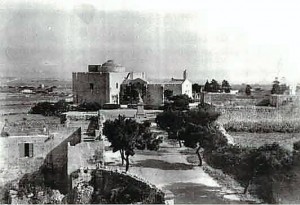 “There was nothing but a few farmhouses in the area. However, when a housing estate was built in proximity to this church, it made sense to revamp this building to provide service to the inhabitants who lived close by. Since my father was considering leaving his job at the parish church, Fr Ġwann Palmier, who was responsible for St Gregory’s church and also a friend of his, offered him a job there. Soon, my father was appointed as the sacristan of this church and together with Fr Palmier, they began to restore the place back to its glory.”
“There was nothing but a few farmhouses in the area. However, when a housing estate was built in proximity to this church, it made sense to revamp this building to provide service to the inhabitants who lived close by. Since my father was considering leaving his job at the parish church, Fr Ġwann Palmier, who was responsible for St Gregory’s church and also a friend of his, offered him a job there. Soon, my father was appointed as the sacristan of this church and together with Fr Palmier, they began to restore the place back to its glory.”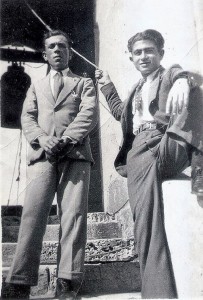 “My father was blessed with a curious nature and a strong determination. He had often listened to the rumours of the old villagers who insisted that there were some people that were buried around the dome of St Gregory’s church. He tried hard to locate this area, especially while doing maintenance work around the dome but he never succeeded.”
“My father was blessed with a curious nature and a strong determination. He had often listened to the rumours of the old villagers who insisted that there were some people that were buried around the dome of St Gregory’s church. He tried hard to locate this area, especially while doing maintenance work around the dome but he never succeeded.”Time would reveal that this was an impossible task since the human remains were actually buried around the roof and not around the dome.
“There was a raised stone close to the exit of the stairway’s room which led to the roof. My father often commented that it looked unusual and out of place. He was convinced that there was something beneath it. One day, there were some men doing maintenance work on the roof and he asked them to try to remove it.”
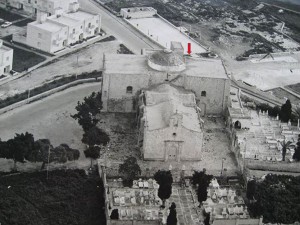 “Once the stone was removed, it was clear that it was covering an opening which led into the church. When my father entered into this space, he found his way to a small chamber which led to U-shaped passages that ran around the roof. Inside the corridors, he found several human remains. I remember him coming home on that day, full of excitement and telling us ‘I found them! I finally found them! I will take you to see them!’”
“Once the stone was removed, it was clear that it was covering an opening which led into the church. When my father entered into this space, he found his way to a small chamber which led to U-shaped passages that ran around the roof. Inside the corridors, he found several human remains. I remember him coming home on that day, full of excitement and telling us ‘I found them! I finally found them! I will take you to see them!’”When Charles visited the passages with his father, he noticed that the skeletons seemed to be lined up near each other along the corridors, as if someone had arranged them in that way. There was about 3 centimetres of dust which had collected in the corridors along the years during which the passages were blocked and closed away.
 Within this dust, a wooden shoe sole with a high heel, a small gilded wooden cross of Byzantine design, odd bits of a gilded wooden frame (perhaps an icon), three coins: two bronze with the cross of the Order, the other gold, but very worn out that it cannot be deciphered, pieces of pottery of the 16-17th century, fragments of animal bones, and a part of a chain mail armour vest, were discovered.
Within this dust, a wooden shoe sole with a high heel, a small gilded wooden cross of Byzantine design, odd bits of a gilded wooden frame (perhaps an icon), three coins: two bronze with the cross of the Order, the other gold, but very worn out that it cannot be deciphered, pieces of pottery of the 16-17th century, fragments of animal bones, and a part of a chain mail armour vest, were discovered.“My father found these passages in pitch darkness but soon he noticed that there were stones blocking five narrow loopholes in the thick walls. Once he removed these stones, he realized that three of them were pointing directly at St Thomas Bay and Marsascala while the other two looked out at Marsaxlokk and Birżebbuġa.”
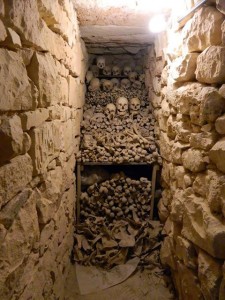 To avoid them being trodden, Debono picked up all the human bones and stacked them at the end of the third corridor. Yet the story does not end there….
To avoid them being trodden, Debono picked up all the human bones and stacked them at the end of the third corridor. Yet the story does not end there….“My father was sure that there was another entrance to these passages within the church itself. He pondered this idea and made several attempts to trace it out. Eventually he came upon a wall cupboard which was situated in an area along the winding staircase and seemed to be of no use. He decided to ask his friend Ġanni Vella, who was known as Ġanni l-ġgant (Ġanni the giant), to bring one of his mason’s tools; a huge iron nail with which building stones were kept in place. He knocked on the wall cupboard with this tool and suddenly, this feature moved out of the wall, revealing another entrance to these passages. It is from this entrance that people get in to view these passages nowadays.”
In 1978, paleopathological studies were done on these human remains by Seshadri Ramaswamy and Joseph Leslie Pace. These experts concluded that the bones appeared to have been exhumed from a cemetery and placed in the passages. However, others find this conclusion hard to believe and they insist that these remains possibly belong to a group of people who were trapped in these corridors whilst hiding there during an Ottoman attack on the village in 1614.
 Every Wednesday after Easter, the traditional feast of St Gregory is celebrated in this historical church in Żejtun. Probably few of those attending are aware of the secret passages and the human skeletons lying within.
Every Wednesday after Easter, the traditional feast of St Gregory is celebrated in this historical church in Żejtun. Probably few of those attending are aware of the secret passages and the human skeletons lying within.Considering that 49 years have passed from this discovery and that several scientific tools are now available to provide more conclusive results, including perhaps dna tests to trace family ancestry, isn’t it time to resolve this mystery by identifying who are these people and how they ended up in these passages?
(This feature was published in the Sunday Times of Malta issued on 25 March 2018)
-
Isn’t it time to solve some of St Gregory’s mysteries?
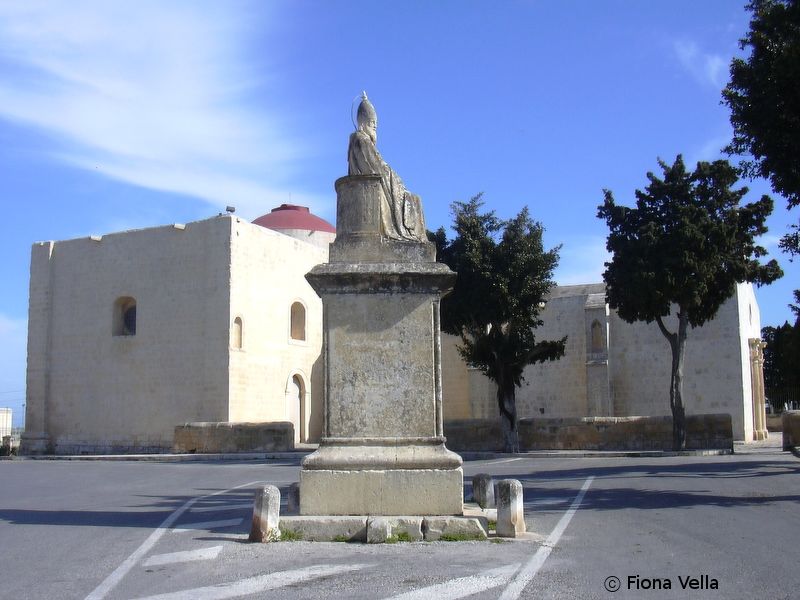
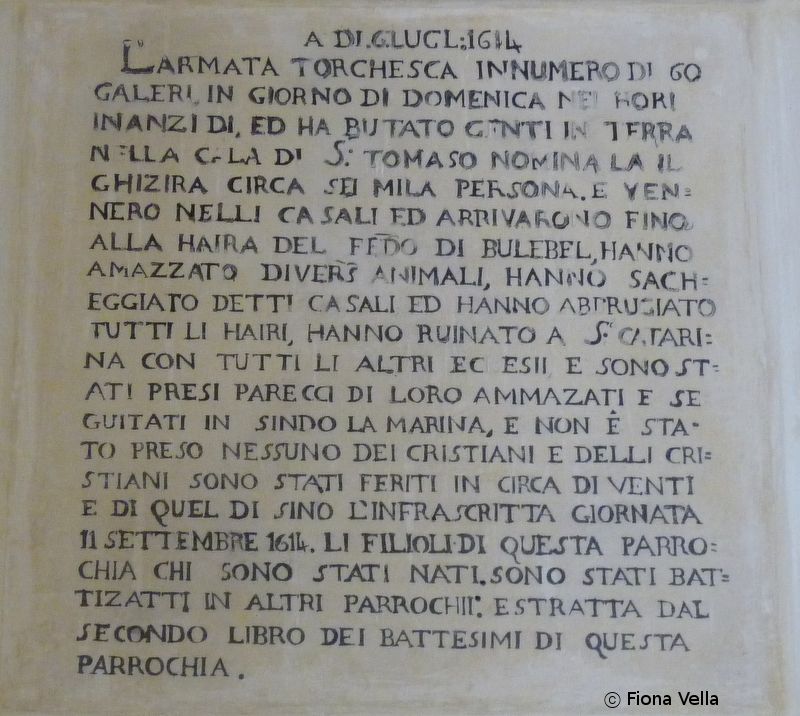


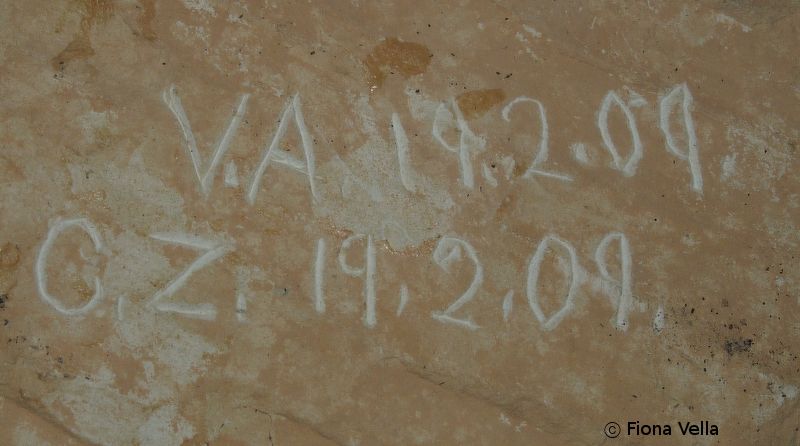
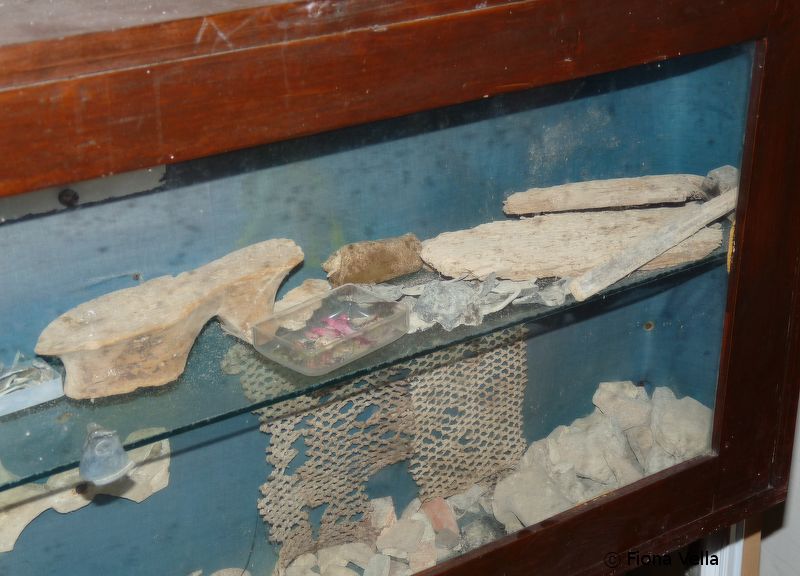
The old parish of St Catherine in Żejtun, popularly known as St Gregory’s, is entrenched with deep-rooted mysteries which up to date remain unsolved.
Some of these dilemmas have been discussed during the second national symposium which was organized by NGO Wirt iż-Żejtun, right in this church, particularly since it is related to the theme that was being commemorated and discussed – the 400th anniversary from the Turkish raid of 1614 on Żejtun and other areas in Malta.
The eight speakers who participated in this national symposium come from various fields of study and therefore each of them presented interesting and significant relative information from different perspectives.
Among the matters treated, one finds the old inscription which for many years was believed to represent a narrative of what took place on that eventful day of the 6th July 1614, when 60 Ottoman galleys set anchor at St Thomas’ Bay and the port of Marsascala, and from there, 6000 Turkish soldiers attacked Żejtun and the surrounding areas. According to this inscription, the Turks pillaged the villages, and the churches and chapels which they came upon, until they were finally reached by Maltese soldiers and the cavalry, and had to retreat back to their ships. Some Maltese were injured but none died, whilst some Turks were killed and others were captured as slaves. However, when referring to some local archives, and also to those who were written by Ottoman authors, one will find details which do not necessarily concur. So what is the real story?
Other curious issues relate to the 1969 discovery of three secret passages within the old church of St Gregory, wherein a number of human bones were also found. Even the discovery itself poses several questions on the true story of their revelation. Indeed, when the passages were located in 1969, right in the beginning of the third corridor, some engravings bearing initials and the date 1909 were noticed, thereby suggesting that these corridors had already been discovered before. Rumours say that after the last discovery, the parish priest had searched among the village elders who had those initials until he traced a certain Carmelo Zahra, known as ‘ir-Rangu’, who confessed that he had entered into these passages when he was a young boy together with some other individuals. He claimed that they had seen skeletons dressed as soldiers in these passages and that they had some weapons and flags with them. Moreover, he said that some people from this group removed these objects and took them away, and threatened the others in order not to mention anything. Indeed, many had been surprised at the frugal objects that were found with the bones in 1969. Could Zahra have been telling the truth?
The remains that were collected during the last discovery included a wooden shoe sole with a high heel, a small gilted wooden cross of Byzantine design, odd bits of a gilted wooden frame (perhaps an icon), three coins: two bronze with the cross of the Order, the other gold, but very worn out that it cannot be deciphered, pieces of pottery of the 16-17th century, fragments of animal bones, and a part of a chain mail armour vest. Presently these are stored in one of the rooms within the church and it seems clear, both from their state of preservation and from the display box in which they stand, that no one has bothered to look at them for whole long years. In fact, very few individuals knew about their existence. It is a pity that these objects are hidden away from researchers and from the public. Don’t they deserve to be conserved and studied and later on displayed appropriately?
Likewise, there are various versions of how and who came upon the opening to the secret passages. One of these claims that this person was none other than Ġann Mari Debono, the sacristan of the church, as published in the Times of Malta dated 15th April 1969. However in 2011, Grezzju Vella talked to journalist Fiona Vella and recounted a slightly different story wherein he declared that he had exposed the opening and entered first in the secret passages.
Certainly, the human remains have also led to another mystery since to date no one knows how and why they were found in these secret passages. A ballad written by Walter Zahra soon after the discovery of 1969 imagined these people to have been the victims of an Ottoman attack after they had gone up to hide in the secret passages and were found by the enemy. Yet by time, this invented story transformed itself into a legend and many villagers believed that this was the truth. However, in 1978, Seshadri Ramaswamy and Joseph Leslie studied these bones and presented a report on their paleopathological studies. They concluded that these bones had been buried in some other place since they had observed that some of the vertebrae had a plug of soil in the vertebral canal. Hence, according to this theory, during a particular period, the secret passages in St Gregory’s church might have been used as an ossuary. Many have asked what sense did it make to carry the bones up to these passages when they could have been stored elsewhere. Yet many more demand why a carbon dating examination has not yet been performed on these bones in order to date these remains and end some of these rumours?
In the coming months, the information that was delivered during the presentations of this national symposium will be published by Wirt iż-Żejtun in the book ‘The Turkish Raid of 1614′. Presently, one may enjoy a pre-publication offer on this book by ordering it through the NGO’s website www.wirtizzejtun.com
(This feature was published in The Sunday Times of Malta dated 24th August 2014)
-
LOOK OUT, BEHIND YOU
GREZZJU VELLA accompanied me up to the roof of St Gregory’s Church, and pointed out the area where the opening to his macabre revelation had been discovered. Boldly he even ventured into the three passageways but he refused to approach the skeletons lying before us in solemn silence.
Since 1969, a series of secret passages accidentally discovered by a 16-year-old Grezzju within the historic church of St Gregory which was rebuilt in the 15th Century, have posed an unsolved riddle. Inside were a heap of skeletons – a shocking discovery that left a deep and troubling impression on the young man. After reporting the find, he decided to avoid speaking about the incident, until now, at age 58, he felt ready to open up to me about it.
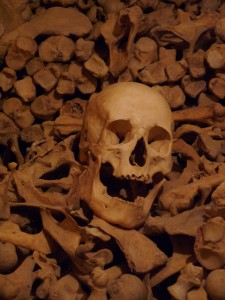 Among the skeletons were some medieval coins, a Byzantine cross, a metal net which historians identified as of a type that used to be worn under a suit of armour, and a shoe-sole. No one knows why these remains were in these tunnels or who the skeletons belonged to. Initially it was believed that they were the unfortunate victims of a Turkish or pirate attack, of the type that were quite frequent in the days of when and after the church was built. However in 1978, nine years after this discovery, these remains have undergone paleopathological studies, producing the first report on medieval bones found in Malta (1). Both the evidence of soil within some bones and the wide discrepancy in the total number of bones pertaining to various parts of the body indicated that probably these were exhumed from some sort of cemetery. Most of the skeletons were very well preserved, possibly because they were confined in a completely covered and well ventilated passage. Among the bones, 19 male skulls and 24 female skulls were discovered, the youngest belonging to a child of about 8 years. It was not possible to arrive at a conclusion about the cause of death of these individuals but the appearance of the bones suggested that these people had died within a short time from each other. Eventually the experts who conducted this analysis, Seshadri Ramaswamy and Joseph Leslie Pace, came to the conclusion that most likely, one of the passages was used as an ossuary. Tentatively they also proposed the idea that these bones could have been moved to this location when some graves were cleared in order to make space for the original extension of the church (2).
Among the skeletons were some medieval coins, a Byzantine cross, a metal net which historians identified as of a type that used to be worn under a suit of armour, and a shoe-sole. No one knows why these remains were in these tunnels or who the skeletons belonged to. Initially it was believed that they were the unfortunate victims of a Turkish or pirate attack, of the type that were quite frequent in the days of when and after the church was built. However in 1978, nine years after this discovery, these remains have undergone paleopathological studies, producing the first report on medieval bones found in Malta (1). Both the evidence of soil within some bones and the wide discrepancy in the total number of bones pertaining to various parts of the body indicated that probably these were exhumed from some sort of cemetery. Most of the skeletons were very well preserved, possibly because they were confined in a completely covered and well ventilated passage. Among the bones, 19 male skulls and 24 female skulls were discovered, the youngest belonging to a child of about 8 years. It was not possible to arrive at a conclusion about the cause of death of these individuals but the appearance of the bones suggested that these people had died within a short time from each other. Eventually the experts who conducted this analysis, Seshadri Ramaswamy and Joseph Leslie Pace, came to the conclusion that most likely, one of the passages was used as an ossuary. Tentatively they also proposed the idea that these bones could have been moved to this location when some graves were cleared in order to make space for the original extension of the church (2).Within the passageways, Grezzju took me back to that fateful day in 1969.
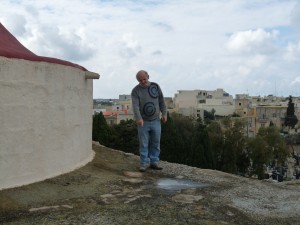 “I had never heard any rumours about the existence of secret passages built round the dome of St Gregory’s church in Żejtun. If I had known, I would certainly have kept away from the roof of the church upon which one day I was thoughtlessly scratching away – a scratching that revealed the sealed opening.
“I had never heard any rumours about the existence of secret passages built round the dome of St Gregory’s church in Żejtun. If I had known, I would certainly have kept away from the roof of the church upon which one day I was thoughtlessly scratching away – a scratching that revealed the sealed opening.I was helping with the maintenance of the wooden apertures of the old church, together with my uncle Carmelo Spiteri and a fellow worker Ċikku Zammit, when Dun Ġwann Palmier asked us to take a look at the roof as it was leaking rain-water. Up we went, walking around the ancient dome which is thought to be one of the oldest domes in Malta. The views up there are beautiful… at least if you avoid looking at the nearby cemetry crowded with ghostly white-marbled tombs. I don’t know why but I always had an instinctive fear of the dead and death itself, a strong gut-feeling which I could not suppress, not even today.
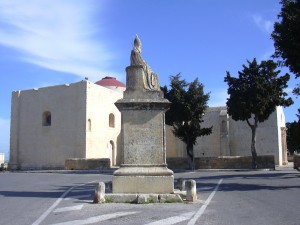 I was probably just trying to kill time as I sat down and scraped off at a narrow fracture on the roof whilst the others were inspecting the rest of the area in order to identify the parts where grouting was needed. To my surprise, the more I hacked at the crack, the more it widened, till at one point I decided to throw a pebble inside to see whether I could hear it fall into the church below. However oddly enough, when I threw it in, I heard it falling nearby and I realized immediately that there could be some sort of structure within the dome itself. I called the others who at first did not take much notice of what I was doing, but when it became evident that there was an ashlar block, my uncle urged me to carve it out. Curiously I slashed off the remaining sealant and on taking the block away, we found that it had been acting as a perfect wedge to lock the opening to a chamber.
I was probably just trying to kill time as I sat down and scraped off at a narrow fracture on the roof whilst the others were inspecting the rest of the area in order to identify the parts where grouting was needed. To my surprise, the more I hacked at the crack, the more it widened, till at one point I decided to throw a pebble inside to see whether I could hear it fall into the church below. However oddly enough, when I threw it in, I heard it falling nearby and I realized immediately that there could be some sort of structure within the dome itself. I called the others who at first did not take much notice of what I was doing, but when it became evident that there was an ashlar block, my uncle urged me to carve it out. Curiously I slashed off the remaining sealant and on taking the block away, we found that it had been acting as a perfect wedge to lock the opening to a chamber.We decided to stop and called for Dun Gwann to come and have a look. The discovery left him puzzled because although he had been responsible for the upkeep of the church for some time, he had never known about this chamber, although he had heard folk tales of hidden passages located in the vicinity of the church. Soon after we were also joined by Ġanmarì Debono, the sacristan of the church, who also had no idea where this opening could lead to. Since I was the youngest and the leaner one, it was decided that I should be lowered down with a rope so that I could see what was inside.
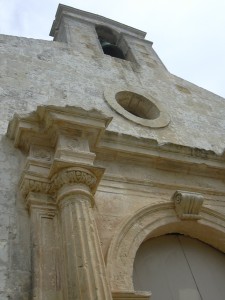 They tied a rope around my waist and gave me a box of matches to find my way through in the darkness. As soon as I touched the floor I lit the first match and in the few seconds of light that it gave me, I managed to see that I was in some sort of passage. With the aid of the fleeting weak light of one match after another, I walked a distance of about 30 feet, but there was much more space in front of me. I hesitated and nervously turned back, alerting the others that the area covered much more than we had originally thought.
They tied a rope around my waist and gave me a box of matches to find my way through in the darkness. As soon as I touched the floor I lit the first match and in the few seconds of light that it gave me, I managed to see that I was in some sort of passage. With the aid of the fleeting weak light of one match after another, I walked a distance of about 30 feet, but there was much more space in front of me. I hesitated and nervously turned back, alerting the others that the area covered much more than we had originally thought.It was then that Dun Gwann had a premonition that I had found the enigmatic passages that people used to narrate stories about. Strangely enough, some years earlier some people had tried to unveil the truth about these tales by trying to open through a side of the dome, but they had not found anything. Dun Gwann told me that the passage would probably lead all the way round the dome, and he calmly encouraged me to go back and find out. He assured me that I would be safe as I was securely tied to the rope, so I plucked up some courage and went back in.
The remaining matches accompanied me along the passage where it abruptly seemed to end, when I suddenly found myself treading on a mass of objects scattered beneath my feet. I felt around with my hands and my fingers came to something resting on the wall in front of me. The darkness was complete while I fumbled at the object to try and understand what it was. My fingers ran over two gaping holes… and then I felt what seemed to be a row of teeth! To my utter shock I recognized that I was holding a skull!
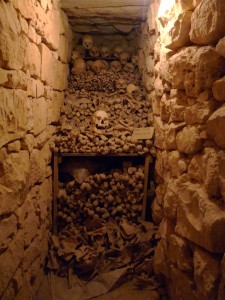 I will never forget the sound of crunching bones as, having let go of the skull with a scream, I turned on my heels and raced back to the faint safety of the light where I had come from. Distraught and agitated I told the others what I had found and left the rest to them.
I will never forget the sound of crunching bones as, having let go of the skull with a scream, I turned on my heels and raced back to the faint safety of the light where I had come from. Distraught and agitated I told the others what I had found and left the rest to them.The incident devastated me at the time, as the fear of anything associated with death that had always lurked within me came out with a vengeance and engulfed me in a state of shock. An ugly rash broke out over my skin and it took me months to calm down completely. I remember my mum Michelina being enraged at my uncle who had allowed me to go down there even though he was aware of my phobia.
From then on I rarely even mentioned this incident to anyone. And even though news of the discovery of the secret passages was quite a sensation back in 1969, I did not reveal to any of my school friends that I had played such an important role in their exposure, I don’t know why. Maybe I simply wanted to be left alone with the hope that one day I would forget this terrible experience. Yet I never really succeeded in doing this, and even though my parents and my brother are buried in the church’s cemetry, for many years I could not ever convince myself to return there. Though I live in the vicinity of the church itself, I’ve tried my best to always avoid going near it. It makes me feel uneasy.
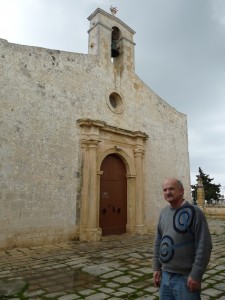 This is the first time that I have been in these passages since that fateful day 42 years ago… and this is the first time I’ve told the story in its entirety to someone from the media. But today I was determined to settle this long-standing debt that has ruled my life for so long and come to terms with the experience. It’s time to move on.”
This is the first time that I have been in these passages since that fateful day 42 years ago… and this is the first time I’ve told the story in its entirety to someone from the media. But today I was determined to settle this long-standing debt that has ruled my life for so long and come to terms with the experience. It’s time to move on.”And with that, we moved out of the haunting passages. Each year, after Easter, a votive traditional procession culminates at this magnificent church which is endowed with distinguished culture, history and architecture. But few of the faithful who congregate for the procession probably know of the enigma waiting to be resolved, save for the few who remember hearing about the discovery all those years ago. A recently formed NGO bearing the name of Wirt iż-Żejtun has vowed to investigate further this unsolved mystery. Maybe finally the time will come for these souls to tell the story and then forever rest in peace.
References
(1) Ramaswamy S & Pace J. L, 1979. The medieval skeletal remains from St. Gregory’s Church at Żejtun (Malta) – Part 1 Paleopathological Studies in Archivio Italiano Di Anatomia E Di Embriologia, Vol. LXXXIV – Fasc. 1.
(2) Ramaswamy S & Pace J. L, 1980. The medieval skeletal remains from St. Gregory’s Church at Żejtun (Malta) – Part 2 Anthropological Studies in Archivio Italiano Di Anatomia E Di Embriologia, Vol. LXXXV – Fasc. 1.
(Note: An edited version of this article was published on FIRST magazine - Issue: April 2011)
Travelogue
Archives
| M | T | W | T | F | S | S |
|---|---|---|---|---|---|---|
| « Jan | ||||||
| 1 | 2 | 3 | 4 | 5 | 6 | 7 |
| 8 | 9 | 10 | 11 | 12 | 13 | 14 |
| 15 | 16 | 17 | 18 | 19 | 20 | 21 |
| 22 | 23 | 24 | 25 | 26 | 27 | 28 |
| 29 | 30 | |||||
Recent Posts
- A MATTER OF FATE
- MALTA’S PREHISTORIC TREASURES
- THE MAGIC IS IN THE DETAIL
- THE SELLING GAME
- NEVER FORGOTTEN
- Ġrajjiet mhux mitmuma – 35 sena mit-Traġedja tal-Patrol Boat C23
- AN UNEXPECTED VISIT
- THE SISTERS OF THE CRIB
Comments
- Pauline Harkins on Novella – Li kieku stajt!
- admin on IL-KARNIVAL TRAĠIKU TAL-1823
- Albert on IL-KARNIVAL TRAĠIKU TAL-1823
- Martin Ratcliffe on Love in the time of war
- admin on 24 SENA ILU: IT-TRAĠEDJA TAL-PATROL BOAT C23